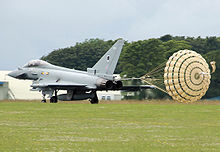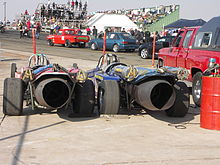| This article needs additional citations for verification. Please help improve this article by adding citations to reliable sources. Unsourced material may be challenged and removed. Find sources: "Drogue parachute" – news · newspapers · books · scholar · JSTOR (September 2009) (Learn how and when to remove this message) |



A drogue parachute, also called drag chute, is a parachute designed for deployment from a rapidly moving object. It can be used for various purposes, such as to decrease speed, to provide control and stability, as a pilot parachute to deploy a larger parachute or a combination of these. Vehicles that have used drogue parachutes include multistage parachutes, aircraft, and spacecraft recovery systems.
The drogue parachute was invented by Russian professor and parachute specialist Gleb Kotelnikov in 1912, who also invented the knapsack parachute. The Soviet Union introduced its first aircraft fitted with drogue parachutes during the mid 1930s; use of the technology expanded during and after the Second World War. A large number of jet-powered aircraft have been furnished with drogue parachutes, including the Boeing B-52 Stratofortress strategic bomber and the Eurofighter Typhoon multirole aircraft; they were also commonly used within crewed space vehicle recovery programmes, including Project Mercury and Project Gemini. The drogue parachute has also been extensively used upon ejection seats as a means of stabilisation and deceleration.
History
The drogue parachute was first used during 1912 in a ground-based parachute test in the absence of airplanes, by Russian inventor Gleb Kotelnikov, who had patented an early canister-packed knapsack parachute a few months before this test. On a road near Tsarskoye Selo (now part of St. Petersburg), Kotelnikov successfully demonstrated the braking effects of such a parachute by accelerating a Russo-Balt automobile to its top speed and then opening a parachute attached to the back seat.

During 1937, the Soviet Union decided to adopt the drogue parachute for the first time on a limited number of their aircraft, specifically those assigned to operate within the Arctic to provide logistical support for the famous polar expeditions of the era, such as the first drifting ice stations North Pole-1, which was launched that same year. The drogue parachute was credited with enabling airplanes to land safely on smaller ice floes that were otherwise unfeasible landing sites.
One of the earliest production-standard military aircraft to use a drogue parachute to slow down and shorten its landings was the Arado Ar 234, a jet-powered reconnaissance-bomber used by the Luftwaffe. Both the trolley-and-skid undercarriage series of eight prototypes for the never-produced Ar 234A series — one on the aircraft, and a separate system on the aft surface of the trolley's main axle — and the tricycle undercarriage-equipped Ar 234B production series were fitted with a drogue parachute deployment capability in the extreme rear ventral fuselage.

During the space race between the United States and the Soviet Union, drogue parachutes were adopted on numerous spacecraft. All human space programs managed by NASA and the Soviets in that time, including Project Mercury and the Apollo program, employed drogue parachutes in their vehicle recovery systems alongside the larger main parachutes. The large budget granted to NASA at the time allowed for the extensive development of parachutes, also including drogues that were designed for deployment in extreme conditions and proved useful for interplanetary missions. The Space Shuttle, which landed on a runway, also found benefit in using a drag chute during landing. Its solid rocket boosters were also recovered with the help of drogue parachutes.
Design and characteristics

In comparison to a conventional parachute, the drogue parachute is more elongated and has a far smaller surface area; as a result, it provides far less drag. The drogue parachute can be deployed at speeds at which conventional parachutes would be torn apart, although it will not slow an object as much as a conventional parachute would do. Due to its simpler design, the drogue parachute is also easier to deploy, minimizing the risk of becoming tangled while unfolding or failing to inflate properly.
Use
Parachuting

Drogue parachutes are sometimes used to deploy a main or reserve parachute by using the drag generated by the drogue to pull the main parachute out of its container. Such a drogue is referred to as a pilot chute when used in a single user (sports) parachute system. The pilot chute is only used to deploy the main or reserve parachute; it is not used for slowing down or for stability. Tandem systems are different; a drogue is deployed shortly after exiting the aircraft to reduce the terminal velocity of the pair of tandem jumpers during freefall. It is later used to deploy the main parachute as on single-person parachutes.
Numerous innovations and improvements have been made to drogue parachutes intended for this purpose; examples include a patent for an antispinning feature granted during 1972, and improved force distribution granted in 2011.
Deceleration

When used to shorten an aircraft's landing distance, a drogue chute is called a drag parachute or braking parachute. They remain effective for landings on wet or icy runways and for high-speed emergency landings.
Braking parachutes are also employed to slow down cars during drag racing; the National Hot Rod Association requires their installation on all vehicles able to attain speeds of 150 miles per hour or greater. They have also been installed on multiple experimental vehicles intended to conduct land speed record attempts.
Stability

Drogue parachutes may also be used to help stabilise direction of objects in flight, such as thrown RKG-3 anti-tank grenades or air-dropped bombs. Stall recovery parachutes are used to mitigate risk of uncontrollable spins during airworthiness flight testing. It has been used for similar purposes when applied to several nuclear bombs, such as the B61 and B83, slowing the weapon's descent to provide the aircraft that dropped it enough time to escape the nuclear blast.
Drogue parachutes have found use on ejection seats to both stabilise and to slow down almost immediately following deployment, examples include the ACES II personal escape system. Similarly, a number of escape capsules, used on both supersonic aircraft and spacecraft, have employed drogue parachutes both for stability and braking, allowing either a main chute to be deployed or for the pilot to exit the capsule and use a personal parachute.

Drogue parachutes remain a key technology for spaceflight, because they can be used to gain control of very fast descents, including those of spacecraft during atmospheric entry. They are usually deployed until having established entry conditions that allow for the use of main parachutes or retropropulsion. These include the Boeing X-37 spaceplane, SpaceX Dragon capsules and fairing halves, Rocket Lab Electron first stages, ISRO's Gaganyaan modules and the Chang'e 5 re-entry craft. The Stardust and OSIRIS-REx sample return capsules and all successful Mars landing missions as of January 2024 used supersonic drogue parachutes. Some high-altitude rockets have also used drogue chutes as part of a dual-deployment system, subsequently deploying a main parachute to control and slow their descent.
See also
References
- ^ "Parachuting at the site Divo: The Russian Book of records and achievements" (in Russian). bibliotekar.ru.
- ^ Lowry, Charles H. "Space Shuttle Orbiter Drag Chute Summary" (PDF). NASA Technical Reports Server.
- "Parachute, Drogue, Mercury". Smithsonian Institution, National Air and Space Museum. Retrieved 17 June 2020.
- "Parachute, Drogue, Gemini". Smithsonian Institution, National Air and Space Museum. Archived from the original on 17 June 2020. Retrieved 17 June 2020.
- Anita Sengupta; Ricardo Machin; Gary Bourland; Ellen Longmire; Mitch Ryan; Erik Haugen; Edward White; James Ross; Joes Laguna; Robert Sinclair; Elsa Hennings; Daniel Bissell (2012). "Performance of a conical ribbon drogue parachute in the wake of a subscale Orion command module". 2012 IEEE Aerospace Conference. IEEE Xplore. pp. 1–11. doi:10.1109/AERO.2012.6186996. ISBN 978-1-4577-0557-1. S2CID 35463923.
- "Soyuz parachutes to Safe Landing – Space Station Crew returns after 186 Days in Orbit – Soyuz TMA-19M | Spaceflight101". 2016-06-18. Retrieved 2024-01-16.
- Why is NASA Still Using 1960's Parachute Test Results?, retrieved 2024-01-16
- Wood, T. David; Kanner, Howard S.; Freeland, Donna M.; Olson, Derek T. (2012). "SOLID ROCKET BOOSTER (SRB): FLIGHT SYSTEM INTEGRATION AT ITS BEST" (PDF). NASA Technical Reports Server.
- "Relive Apollo 11 Glossary: Abbreviations and Acronyms". NASA. Retrieved 17 June 2020.
- Brain, Marshall (27 August 2002). "How Skydiving Works". adventure.howstuffworks.com. Retrieved 17 June 2020.
- "What are Drogues in Skydiving?". skydivecal.com. 9 December 2018.
- "Aerial flare with drogue parachute". 1972.
- "Skydiving equipment to distribute the tension forces of a drogue parachute". 2011.
- "Deceleration Parachutes". Miles Manufacturing. Retrieved 17 June 2020.
- "North American Eagle Project: Deceleration – High Speed Parachute Systems". Archived from the original on 9 October 2010.
- "Engineering Special Report: How to slow a supersonic car with a parachute". bloodhoundlsr.com. 27 August 2019.
- Qiu, Zhijie; Dai, Wei; Guan, Gaozhi (November 2021). "Research on Stall Recovery Parachute Flight Deployment Tests". 2021 International Symposium on Computer Science and Intelligent Controls. IEEE. pp. 24–27. doi:10.1109/ISCSIC54682.2021.00016.
- "ACES II Ejection Seat Stabilizing Drogue Parachute". Life Support International. Retrieved 17 June 2020.
- ^ "Drogue Parachutes". apogeerockets.com. Retrieved 17 June 2020.
- ^ House, Marie (24 May 2019). The Design and Development of an Electromechanical Drogue Parachute Line Release Mechanism for Level 3 High-Power Amateur Rockets (Honors thesis). Portland State University. doi:10.15760/honors.770.
- Stephen A. Whitmore; Brent R. Cobleigh; Steven R. Jacobson; Steven C. Jensen; Elsa J. Hennings. "Development and Testing of a Drogue Parachute System for X-37 ALTV/B-52H Separation" (PDF). NASA. Archived from the original (PDF) on 2022-01-21. Retrieved 2020-06-17.
- Stephen A. Whitmore; Elsa J. Hennings (November 2007). "Design of a Passively Reefed, Collapsible Drogue Parachute System". Journal of Aircraft. 44 (6): 1793–1804. doi:10.2514/1.28437.
- SpaceX. "Dragon". SpaceX. Retrieved 2024-01-16.
- Messier, Doug (12 April 2018). "More Details on SpaceX's Fairing & Drogue Parachute Recovery Efforts". parabolicarc.com.
- Berger, Eric (2022-05-03). "Rocket Lab catches a 1-ton booster falling back from space". Ars Technica. Retrieved 2022-05-04.
- "ISRO Conducts Drogue Parachute Deployment Tests for Gaganyaan Mission". www.isro.gov.in. Retrieved 2024-02-04.
- Huang, Wei; Rong, Wei; Liu, Dahai; Jiang, Changhong; Jia, He; Bao, Jinjin; Fang, Jishou (January 2021). "Design and Realization of Recovery System of Chang'e-5 Reentry Spacecraft". Space: Science & Technology. 2021. doi:10.34133/2021/9898756. ISSN 2692-7659.
- Aljuni, Thomas; Linn, Timothy; Willcockson, William; Everett, David; Ronald, Mink; Wood, Joshua (June 8, 2015). "OSIRIS-REx, Returning the Asteroid Sample" (PDF). doi:10.1109/AERO.2015.7118988.
- Koerner, Brendan I. "The Supersonic Parachutes Carrying NASA's Martian Dreams". Wired. ISSN 1059-1028. Retrieved 2024-01-17.
External links
- Marine parachute drogues
- PTK-10SK Parachute braking system
- PTK-29SK Parachute braking system
- PTK-25 Parachute braking system
- PTK-10240-65 series 2 Parachute braking system